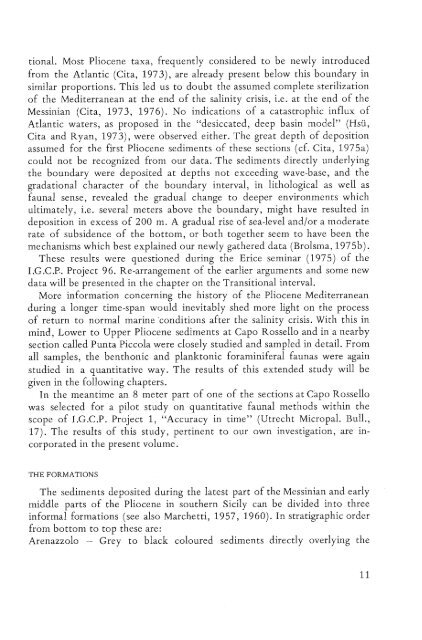UTRECHT MICROPALEONTOLOGICAL BUllETINS
UTRECHT MICROPALEONTOLOGICAL BUllETINS
UTRECHT MICROPALEONTOLOGICAL BUllETINS
Create successful ePaper yourself
Turn your PDF publications into a flip-book with our unique Google optimized e-Paper software.
tional. Most Pliocene taxa, frequently considered to be newly introduced<br />
from the Atlantic (Cita, 1973), are already present below this boundary in<br />
similar proportions. This led us to doubt the assumed complete sterilization<br />
of the Mediterranean at the end of the salinity crisis, i.e. at the end of the<br />
Messinian (Cita, 1973, 1976). No indications of a catastrophic influx of<br />
Atlantic waters, as proposed in the "desiccated, deep basin model" (Hsii,<br />
Cita and Ryan, 1973), were observed either. The great depth of deposition<br />
assumed for the first Pliocene sediments of these sections (cf. Cita, 197Sa)<br />
could not be recognized from our data. The sediments directly underlying<br />
the boundary were deposited at depths not exceeding wave-base, and the<br />
gradational character of the boundary interval, in lithological as well as<br />
faunal sense, revealed the gradual change to deeper environments which<br />
ultimately, i.e. several meters above the boundary, might have resulted in<br />
deposition in excess of 200 m. A gradual rise of sea-level and/or a moderate<br />
rate of subsidence of the bottom, or both together seem to have been the<br />
mechanisms which best explained our newly gathered data (Brolsma, 1975b).<br />
These results were questioned during the Erice seminar (1975) of the<br />
I.G.C.P.. Project 96. Re-arrangement of the earlier arguments and some new<br />
data will be presented in the chapter on the Transitional interval.<br />
More information concerning the history of the Pliocene Mediterranean<br />
during a longer time-span would inevitably shed more light on the process<br />
of return to normal marine 'conditions after the salinity crisis. With this in<br />
mind, Lower to Upper Pliocene sediments at Capo Rossello and in a nearby<br />
section called Punta Piccola were closely studied and sampled in detail. From<br />
all samples, the benthonic and planktonic foraminiferal faunas were again<br />
studied in a quantitative way. The results of this extended study will be<br />
given in the following chapters.<br />
In the meantime an 8 meter part of one of the sections at Capo Rossello<br />
was selected for a pilot study on quantitative faunal methods within the<br />
scope of I.G.C.P. Project 1, "Accuracy in time" (Utrecht Micropal. Bull.,<br />
17). The results of this study, pertinent to our own investigation, are incorporated<br />
in the present volume.<br />
The sediments deposited during the latest part of the Messinian and early<br />
middle parts of the Pliocene in southern Sicily can be divided into three<br />
informal formations (see also Marchetti, 1957, 1960). In stratigraphic order<br />
from bottom to top these are:<br />
Arenazzolo - Grey to black coloured sediments directly overlying the

















